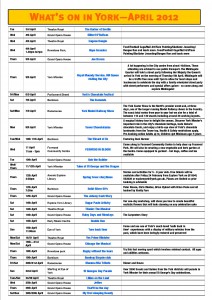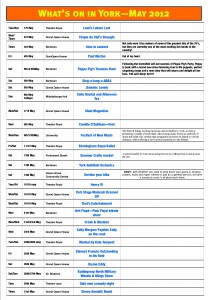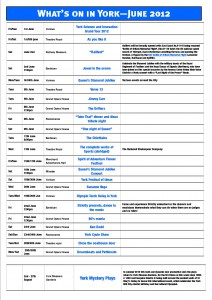Metal thieves to feel the impact of Operation Tornado
From 2 April the fight against metal theft will be taken to a new level as Operation Tornado is launched across the Yorkshire and Humber Region in a bid to restrict the movement of stolen metal.
The launch signals a warning to criminals that there is no market for stolen metals in Yorkshire and the Humber.
Already successfully trialled in the North East region earlier this year, Operation Tornado is being implemented by the Association of Chief Police Officers (ACPO), the Home Office, British Metals Recycling Association (BMRA), British Transport Police (BTP) North Yorkshire Police, South Yorkshire Police, West Yorkshire Police and Humberside Police.
Acting Chief Inspector Sarah-Jane Sanderson, of North Yorkshire Police, said:
“As from 2 April, anyone who wants to sell metal to participating dealers in North Yorkshire will now be required to provide proof of their identity by producing either a photo driving licence, passport or national identity card – which must show an address – supported by a utility bill under three months old which also shows their address.
She added: “This is another tool which will help the police stem the tide of metal theft by cutting off criminals’ cash-flow. We have watched the North East pilot with interest and are extremely pleased that we are able to adopt the initiative for North Yorkshire and the City of York.
“The aim is to encourage the estimated 50 to 60 registered scrap metal dealers across North Yorkshire to sign up to the scheme to help fight the trade in stolen metal, making it more difficult for thieves to make money as we will have removed all their avenues to sell metal on.”
“What’s on in York” April – June 2012
York’s Orbital Cycle Route open
The Orbital Route is a circular strategic cycle route around the city delivered by City of York Council in response to feedback from York residents wanting quiet mainly off-road routes between the inner and outer ring road. The Orbital Cycle Route is designed to allow users to ‘hop on’ and then ‘hop off’ to destinations around the city. Destinations are signposted by the already familiar blue signs as well as numbered way markers (ranging from 1 to 26) that can also be seen on the popular cycle route map. With the previous Cycling City York and current i Travel York programmes, a number of infrastructure improvements have been made to plug gaps in the existing cycle route network. This will help to ensure that those making journeys by bicycle can travel all the way around York quickly, easily and more safely.
The Orbital Cycle Route, which is depicted on the York Cycle Route Map, begins and ends at Millennium Bridge and features 26 distinctive, numbered metal ‘way-markers’, which highlight the route at key points around the city. From there, the route heads west through South Bank and skirts around The Knavesmire before crossing Hob Moor. It then continues north along quiet residential streets in Acomb before crossing the River Ouse at Clifton Bridge.
From Clifton Green, the route proceeds up Water Lane and Kingsway North, taking advantage of a newly-built off-road cycle path, before heading onto Crichton Avenue, where major improvements were carried out during 2010. It then joins up with the off-road Sustrans cycle track, known as the Foss Islands Route, and continues onto James Street before reaching the junction with Lawrence Street, where major improvements to the signals and cycle crossings have recently taken place. The route then returns to Millennium Bridge from the east via quiet residential roads close to The Barbican and along the riverside cycle track at New Walk from the Blue Bridge.
For more information about cycling facilities and infrastructure in York, visit the Cycling City York website at: www.cyclingcity.york.org.uk, Later in the year there will be a new website replacing this as part of the i Travel York programme catering for all York’s travel needs and information.
“Dig up your Roots” – York Libraries launch family history sessions
Dig up your roots this Spring to find out more about your family tree.
Our learning activities are aimed at beginners and will show you how to access and use local and family history resources and archival materials to trace your ancestors.
Ancestry sessions for beginners
These sessions are aimed at absolute beginners of all ages who are looking to research their family tree.
The aim is to give learners the confidence to begin researching their family history using the Ancestry website, which is available free within York Libraries.
•Tang Hall: Monday 2 April, 10.30am – 11.30am
•Copmanthorpe: Monday 16 April, 9.15am – 10.15am
•Poppleton: Wednesday 9 May, 10.30am – 11.30am
•Haxby: Monday 21 May, 9.45am – 10.45am
•Huntington: Tuesday 12 June, 10.30am – 11.30am
•Bishopthorpe: Wednesday 20 June, 2.30pm – 3.30pm
Introduction to family history resources on the internet
This free session is suitable for anybody who has a basic knowledge of how to use computers, and wants to find out about free family history websites. The sessions will cover Ancestry and other websites for UK Birth, Marriage and Death Records and UK census records.
•York Explore: Saturday 26 May, 2.30pm – 4.30pm
Family history for beginners
This free workshop aims to cover the basics of how to start your family tree, and will introduce useful resources like Civil Registration records, census records and parish registers to get you started.
•York Explore: Thursday 20 April, 10am – 12 noon
•York Explore: Thursday 31 May, 2pm – 4pm
•York Explore: Thursday 28 June, 10am – 12 noon
For more information or to book onto any of the courses, please contact your local library staff.
Spring Fever story events for children this Easter
Spring Fever at Explore Acomb
Thursday 12 April, 2pm – 3pm at Explore Acomb
Stories and activities for 5 – 11 year olds. Free tickets available from Explore Acomb on (01904) 552651 or acomb.library@york.gov.uk . Places are limited so prior booking is advisable.
Spring Fever at Explore York
Monday 2 April, 2.30pm – 3.30pm at Explore York
Stories and activities for 5 – 8 year olds. Free tickets available from Explore York on (01904) 552828 or exploreyork@york.gov.uk. Places are limited so prior booking is advisable.
Cycling – Police advice on bicycle safety and security
“As in any other part of the country, North Yorkshire and the City of York suffer from bicycle theft – both from street locations and from houses and out-buildings.
As a force we work hard with agencies and the public to reduce bicycle crime and to promote security. This includes talking to schools, workforces and individuals to ensure cycle users understand the principals of prevention and how to report a theft if one occurs.
From analysing details of reported incidents, the main area of concern is how users either leave cycles unlocked or use inadequate locks. The cycles are also left in inappropriate areas such as unlit streets, out of sight, around the corners of buildings or simply dumped on a pavement. These are all places criminals look for and know about.
Basic advice
The Home Office has issued the following advice to help protect your bicycle:
•When buying a bike, budget for security.
•Take out insurance, either by extending your home contents insurance or through a separate policy. Cycling organisations and bike shops may offer specialist cover. Do this at the time of purchasing the bike, otherwise you may not get around to it.
•Record and register your bike.
– Register your bicycle model, make and frame number. This assists the police in returning recovered bikes to their rightful owners. Contact your local police station for further advice.
– Take a clear, colour photograph of your bike and make a written record of its description, including any unique features, so that you can report it accurately if stolen.
•Security mark the bicycle. A number of proprietary marking and tagging systems are available. To be effective a security marking must:
– be clearly visible – advertise that the bike is security marked or tagged. For example, attaching a clearly visible label is a simple option.
– be secure – for example, by using a tamper-resistant label, etching, etc, or an inaccessible electronic device.
– be placed in at least two separate locations, preferably on or in the frame. At least one of these locations should not be clearly visible.
– give clear information via the visible mark (label, etching, etc) that will quickly allow police to identify the method of security marking or tagging (and where applicable the registration company), and through this identify the owner. Crime Prevention Officers or security marking companies can advise if you are not sure what information to include.
Secure cycle parking
There are designated areas within the towns and cities of North Yorkshire which offer secure parking for cycles. These can be found at train stations, multi-storey car parks and in main shopping areas.
A number of local authorities publish details of cycle lockers and other forms of secure parking, including York Council.
Locks
There are many different products on the market and price is not necessarily a reliable indicator of quality. The most important factor is how long the product can resist attack.
To guard against the opportunist thief you need a product that has resisted attack for one minute. To guard against the determined thief you need a product that has resisted attack for three minutes. To guard against the dedicated thief you need a product that has resisted attack for five minutes.
Hardened steel D-shaped locks are recommended as the minimum standard. It is worth spending proportionately more on a lock for a more expensive bike.
The Cycle Passport
One of the new prevention tools in use is a scheme called the Cycle Passport. The passport is designed for the cycle owner to record all aspects of the bike and also allows a photo to be attached. This is then stored in a safe place and should only be used in case the cycle is stolen. It will help the officer to gain a full description and help identify the cycle if recovered. The information can also be passed on to local cycle stores in case the offender tries to sell on the bike.
Know your bike
Just in case the worst does happen, make sure you are able to describe your bike properly to police.
Further information
You can get more advice on keeping your bicycle safe from Immobilise and the Home Office, or from Safer York Partnership’s Operation Spoke.
- « Previous
- 1
- …
- 6
- 7
- 8




